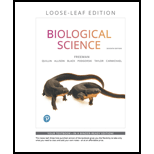
Concept explainers
Introduction:
The mycelia are the vegetative structure of the
Answer to Problem 1TYK
Correct answer:
The mycelial growth habit leads to a body with a high surface-area-to-volume ratio to have a large surface area for absorption.
Explanation of Solution
Explanation/justification for the correct answer:
Option (a) is given that the mycelial body has a high surface-area-to-volume ratio to have a large surface area for absorption. The fungi feed on the dead and the decaying organism. The long length of mycelia increases its surface area that helps them to easily absorb the food material (nutrients). Hence, Option (a) is correct.
Explanation for incorrect answer:
Option (b) is given that the mycelial body has a high surface-area-to-volume ratio, so that the hyphae that makeup mycelia are long, thin tubes. The large surface area of mycelia helps in absorption of nutrients. So, it is a wrong answer.
Option (c) is given that the mycelial body has a high surface-area-to-volume ratio, so that most hyphae are broken up into compartments by walls called septa, although some exist as single, gigantic cells. The distribution of mycelial body into fragments helps in asexual reproduction and has no relation to the large surface area of the mycelial body. So, it is a wrong answer.
Option (d) is given that mycelial body has a high surface-area-to-volume ratio so, that the hyphae can infiltrate living and dead tissues. The infiltration of living or dead tissue is done by the pores in the septa that separate the hyphae into compartments. So, it is a wrong answer.
Hence, options (b), (c), and (d) are incorrect.
The mycelial growth habit results in the development of high surface-area-to-volume ratio. The large surface area is important, so that the mycelia have increased area for the absorption of nutrients from the dead decaying food source.
Want to see more full solutions like this?
Chapter 29 Solutions
Biological Science, Loose-leaf Edition (7th Edition)
- What is the structure and function of Eukaryotic cells, including their organelles? How are Eukaryotic cells different than Prokaryotic cells, in terms of evolution which form of the cell might have came first? How do Eukaryotic cells become malignant (cancerous)?arrow_forwardWhat are the roles of DNA and proteins inside of the cell? What are the building blocks or molecular components of the DNA and proteins? How are proteins produced within the cell? What connection is there between DNA, proteins, and the cell cycle? What is the relationship between DNA, proteins, and Cancer?arrow_forwardWhy cells go through various types of cell division and how eukaryotic cells control cell growth through the cell cycle control system?arrow_forward
- In one paragraph show how atoms and they're structure are related to the structure of dna and proteins. Talk about what atoms are. what they're made of, why chemical bonding is important to DNA?arrow_forwardWhat are the structure and properties of atoms and chemical bonds (especially how they relate to DNA and proteins).arrow_forwardThe Sentinel Cell: Nature’s Answer to Cancer?arrow_forward
- Molecular Biology Question You are working to characterize a novel protein in mice. Analysis shows that high levels of the primary transcript that codes for this protein are found in tissue from the brain, muscle, liver, and pancreas. However, an antibody that recognizes the C-terminal portion of the protein indicates that the protein is present in brain, muscle, and liver, but not in the pancreas. What is the most likely explanation for this result?arrow_forwardMolecular Biology Explain/discuss how “slow stop” and “quick/fast stop” mutants wereused to identify different protein involved in DNA replication in E. coli.arrow_forwardMolecular Biology Question A gene that codes for a protein was removed from a eukaryotic cell and inserted into a prokaryotic cell. Although the gene was successfully transcribed and translated, it produced a different protein than it produced in the eukaryotic cell. What is the most likely explanation?arrow_forward
 Biology (MindTap Course List)BiologyISBN:9781337392938Author:Eldra Solomon, Charles Martin, Diana W. Martin, Linda R. BergPublisher:Cengage Learning
Biology (MindTap Course List)BiologyISBN:9781337392938Author:Eldra Solomon, Charles Martin, Diana W. Martin, Linda R. BergPublisher:Cengage Learning Biology: The Unity and Diversity of Life (MindTap...BiologyISBN:9781305073951Author:Cecie Starr, Ralph Taggart, Christine Evers, Lisa StarrPublisher:Cengage Learning
Biology: The Unity and Diversity of Life (MindTap...BiologyISBN:9781305073951Author:Cecie Starr, Ralph Taggart, Christine Evers, Lisa StarrPublisher:Cengage Learning Concepts of BiologyBiologyISBN:9781938168116Author:Samantha Fowler, Rebecca Roush, James WisePublisher:OpenStax College
Concepts of BiologyBiologyISBN:9781938168116Author:Samantha Fowler, Rebecca Roush, James WisePublisher:OpenStax College
 Biology: The Dynamic Science (MindTap Course List)BiologyISBN:9781305389892Author:Peter J. Russell, Paul E. Hertz, Beverly McMillanPublisher:Cengage Learning
Biology: The Dynamic Science (MindTap Course List)BiologyISBN:9781305389892Author:Peter J. Russell, Paul E. Hertz, Beverly McMillanPublisher:Cengage Learning Biology Today and Tomorrow without Physiology (Mi...BiologyISBN:9781305117396Author:Cecie Starr, Christine Evers, Lisa StarrPublisher:Cengage Learning
Biology Today and Tomorrow without Physiology (Mi...BiologyISBN:9781305117396Author:Cecie Starr, Christine Evers, Lisa StarrPublisher:Cengage Learning





